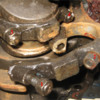quote:
Originally posted by SoCalCat:
why must the rod end be re-sized if the bolts are replaced?
In my experience it doesn't but what you need to do is clamp the cap to the rod in a vise as you insert the new bolt.
If you don't, the cap will misalign to the rod. You can feel even .001" with your fingers.
Either way, you still need to take the rod out of the engine. That means taking the crank out also and everything else that is involved.
You are better off pulling the entire engine out to do that.
The real issue that is being avoided is that the rod bearings are held in place very tentatively with a tab that aligns with notches in the rod and rod cap. The tolerance for them is very small.
Changing the rod bolts will sometimes distort the cap out of round by about .001" or so. This increases the possibility of spinning the bearing.
Some of the bearings have dowel holes in them but using dowels in the rods or caps has issues too. They pop out under stress, and if you re-size the rods, they have to be removed to do that, then re-installed which reduces the ability of the knurls on the pin to hold it tightly into the rod.
No solution is perfect!
Most engine builders will tell you, as George has said, to resize the rods when you change the bolts to make sure they are round.
That requires a special connecting rod resizing machine.
This is cheap insurance when the engine is apart since they charge 4 or 5 dollars each rod to do this.
As far as the bolt and nut, I have found that they tend to need to be re-torqued to specs after they have been run.
I've seen this on all engines. Not just the C.
What happens is the rod bolts tend to stretch.
That in itself isn't unusual at all. There are specs now for torquing the rod bolts and measuring the bolt stretch as a spec, rather then reading a torque spec off of a torque wrench.
The bolt manufacturer supplies those specifications to you with the bolts and nuts.
These days ARP rod bolts are the safest and most predictable to use.
Not to contradict anyone but it isn't as simple as just changing the nuts. I honestly don't know if it is wise to go into the engine to change the nuts now?
What you are going to find is that when you remove the existing nuts, you will tend to take some of the threads off of the existing bolts. Then you are in a situation where the bolts should be changed too?
The threads on the connecting rod bolts are not cut as you would with a threading die, they are rolled on a threading machine.
You can't, or shouldn't "chase" the threads on either the bolts or nuts, with a tap and die.
Once you loose parts of the bolt threads, they are no good any more and need to be changed, and you will find that you don't loose chunks of threads necessarily, what will come off is a very fine wire like a human hair. If you get that, the bolt and nut are no longer good, change them both.
THAT RIGHT THERE can be the explanation of why the nuts fail, i.e., the bolt threads were already compromised and reused in a rebuild.
Who can argue with the known disasters but if you want to look at it as an actuary would, how many engines with how many thousands of miles are out there that are still running with no problems vs. the literally a couple or few that have broken?
You just don't know the history of the broken engines.
If you read the old magazine article, "Pro-fecting the 351c" by Jack Rousch, he says to just use the Ford Boss 351c bolts and nuts. PERIOD.
Considering he was THE authority on the 351c in the Pro stock days of the engine, I would go with his knowledge AND EXPERIENCE with the engine right there and close the book on it rather than any other heresay evidence that is presented in an online forum today, BUT THAT'S JUST ME and I can be funny that way as to who I accept as an expert on anything?
TO ME, the #1 on the side of the Gapp and Rousch Pinto counts for a lot. There are few that have better credentials then that?
I consider it as a really good Doctors really good advice. Best to consult with YOUR DOCTOR on YOUR SITUATION first.

Now me, I'm not a real doctor, but I do remember trying to convince Linda Vaughn I was...and that I could help her back problem?

The real answer is, "you's pays yours moneys, and you's takes your's chances!" Is it the Lady or the Tiger you will get? I like cats...here kitty kitty!




